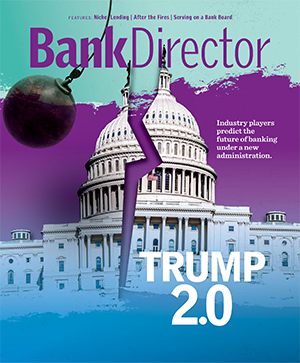Laura Alix is the Director of Research at Bank Director, where she collaborates on strategic research for bank directors and senior executives, including Bank Director’s annual surveys. She also writes for BankDirector.com and edits online video content. Laura is particularly interested in workforce management and retention strategies, environmental, social and governance issues, and fraud. She has previously covered national and regional banks for American Banker and community banks and credit unions for Banker & Tradesman. Based in Boston, she has a bachelor’s degree from the University of Connecticut and a master’s degree from CUNY Brooklyn College.

Your Governance To-Do List: Update Director Qualifications
Regularly reviewing board membership qualifications can help banks achieve strategic goals.
Bank boards may want to review and update their qualifications for new directors soon, if they haven’t done so recently.
Taking a fresh look at the expected qualifications and experience that should be represented in the boardroom can put the board in a better position should a director retire or depart suddenly. That review will also help identify new directors whose skill sets better reflect the bank’s strategic priorities and challenges.
Many banks revisited their director qualifications following the 2007-08 financial crisis, but have not necessarily done so since then, says Robert Fleetwood, a partner with Barack Ferrazzano Kirschbaum & Nagelberg. He makes the case that reviewing board qualifications should be a regular practice for a number of reasons, such as fostering tough conversations with outgoing directors who may be reluctant to give up their seat.
“You never know when a director is going to retire. You never know when you’re going to need new people,” he says. The banking environment has changed dramatically over the past 15 years or so, and that requires new skills and experiences on the board. “With banks expanding their offerings and expanding their geography with fintech, it might make some sense to go ahead and look at that to see if that qualification makes sense or if it should be changed.”
When a board is evaluating the skills it wants in new directors, it should consider the types of businesses the bank is currently in, or wants to be in, says Al Laufenberg, a managing director at Keefe, Bruyette and Woods. It’s also critical that bank boards have enough technology expertise to provide effective oversight of strategic initiatives like fintech partnerships and to understand the language that the bank’s tech executives use.
Data privacy and cybersecurity are two skill sets that a bank board may benefit from having in the mix, says Fleetwood.
Regulators are increasingly taking an interest in board composition and oversight. In October 2023, the Federal Deposit Insurance Corp. issued a notice of proposed rulemaking around corporate governance and risk management. That guidance would apply to state nonmember banks with more than $10 billion of assets, and includes an overview of general obligations of individual directors and an outline of the board’s committee structure. Those banks would also be required to establish a risk committee, with a designated risk expert.
“You’re seeing regulators taking a look at corporate governance and boards, and they’re setting new supervisory expectations around that,” says Grant Butler, a partner with K&L Gates. “That of course, is partially in response to the bank failures [in the spring of 2023], but it’s also the beginning of what may become a trend of increased regulatory interest and guidance around governance of institutions.”
Bank Director’s 2023 Governance Best Practices Survey, conducted last April, found 69% of responding bank directors and CEOs reporting that the board possessed risk expertise. Fifty-seven percent indicated their board had experience with regulations, and 52% reported that technology expertise was represented in their membership. One-third said at least one member had a cybersecurity background.
In May 2023, the New York Department of Financial Services issued proposed guidance outlining its expectations for how banks should develop and maintain character and fitness assessments for directors, senior executives and managers. The state regulator suggested that boards regularly ask directors to review whether they have any debts to the bank or its affiliates, or whether they have any family working for the bank, for example.
Diversity on corporate boards has also come under scrutiny in recent years. For example, Nasdaq recently required that companies trading on its exchange have at least two diverse board members — including one woman and one member of a racial or ethnic minority or an LGBTQ individual. If the company doesn’t have at least two members who meet that definition, it must explain why the board cannot meet that requirement.
Strong corporate governance practices and a healthy level of board refreshment may help a bank remain independent in the long run. For Laufenberg, succession planning issues, including in the boardroom, can serve as a leading indicator that a bank may put itself up for sale at some point.
But trust and respect matter, too.
“If there’s frustration or lack of communication between the board and management, that’s another leading indicator” that a bank will sell, he says. “If you have management teams that are dreading the next board meeting, because they just find it to be cumbersome and not helpful, and you have boards that are very frustrated with management, that’s a leading indicator in our world.”
No matter the skill sets and experiences possessed by directors, it’s important that all board members share the same vision for the organization. A board may find directors who are a good culture fit by vetting candidates early on, and conducting several rounds of interviews with multiple board members and senior executives.
“Boards have to strike the right balance in bringing on new board members, because you want diversity in thought and experiences, but yet, make sure that the new board members share the common goals and aspirations of the organization,” Laufenberg says. “The best result is to have differing points of view, but in the context of a shared common goal.”


